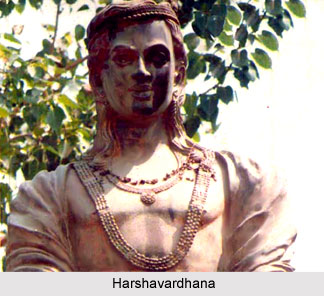 With the sudden downfall of the Gupta Empire back in the 6th century AD the western and witnessed a colossal amount of change. Vardhan dynasty started its progressive rule. Prabhakar Vardhan was the first king of this dynasty with Thanesar as his capital. Religion had undergone a transformation. The field of education witnessed a marked development and it was highly specialized. This dynasty through trade influenced Indian culture and the cultures of the neighbouring countries too.
With the sudden downfall of the Gupta Empire back in the 6th century AD the western and witnessed a colossal amount of change. Vardhan dynasty started its progressive rule. Prabhakar Vardhan was the first king of this dynasty with Thanesar as his capital. Religion had undergone a transformation. The field of education witnessed a marked development and it was highly specialized. This dynasty through trade influenced Indian culture and the cultures of the neighbouring countries too.
Prabhakar Vardhan
Prabhakar Vardhan, the ruler of Sthanvisvara belonged to the Pushabhukti family, who extended his control over neighbouring states. Prabhakar Vardhan was succeeded by his eldest son, Rajya Vardhan. The Vardhan dynasty achieved its glory during the rule of Harshvardhan; the brother of Rajya Vardhan. Evidence of the development of art and culture cannot also be denied.
Harsha Vardhan
Harshvardhan, the descendant of the Vardhan dynasty was born around 580 AD, belonged to Pushibhukti family. The period of his rule was politically extravagant. His kingdom included Punjab, Bengal, Orissa, Gujarat and the entire Indo-Gangetic plain north of the Narmada River. Harsha was a great conqueror and an able administrator. He was responsible for the union of Thanesar and Kannauj. He gradually transferred his capital from Thanesar to Kannauj. Harsha encouraged all artistic endeavors. End in his rule marked the disintegration of the Vardhan Empire.
Economy, Art and Administration of Vardhan Dynasty
Numerous stupas were built in the name of Lord Buddha. University of Nalanda was endowed with grants and donations in order to build up a high security wall around it for its safety against invaders. Music flourished in categories of sacrificial areas, stages, temple precincts, platforms and princely courts. Harshvardhan maintained friendly relations with neighbouring countries in order to maintain the political order and effective administrative system.
Buddhism as a religion received a major boost during the rule of the Vardhan dynasty.
Initially Harsha Vardhan was the follower of Hindu religion. However later he became a Buddhist and followed Mahayana Buddhism. Harsha`s religious inclinations changed into Shaivism and Buddhism from sun worshipping.
Therefore, the Vardhan dynasty flourished until Harshvardhan got defeated in the south of India. This era saw the emergence of Buddhism to a full swing, along with the developments of art, literature and architecture. Harsha was very much instrumental in bringing this transformation, which also shaped up his life.



















